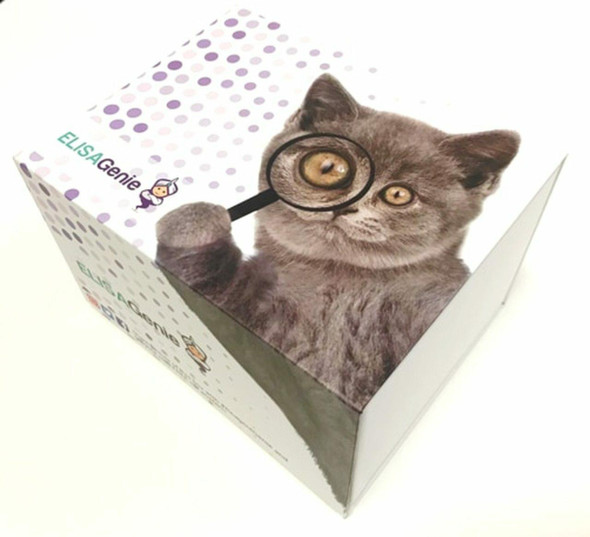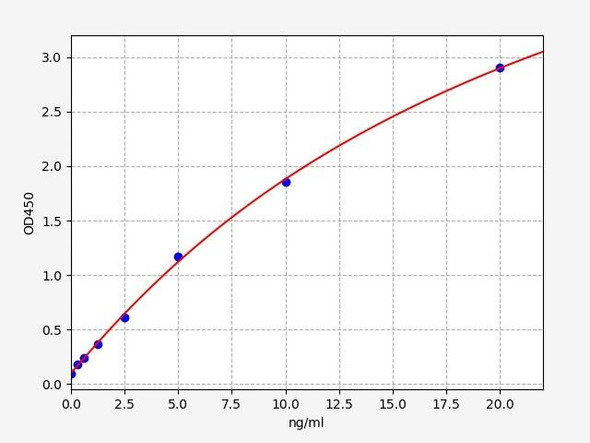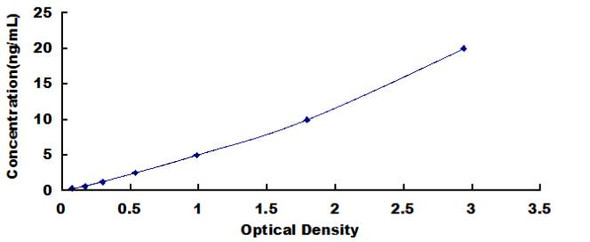Human VDR / Vitamin D Receptor ELISA Kit
- SKU:
- HUFI00691
- Product Type:
- ELISA Kit
- Size:
- 96 Assays
- Uniprot:
- P11473
- Sensitivity:
- 0.375ng/ml
- Range:
- 0.625-40ng/ml
- ELISA Type:
- Sandwich
- Synonyms:
- VDR, Vitamin D Receptor, NR1I1, Nuclear receptor subfamily 1 group I member 1, 1, 25-dihydroxyvitamin D3 receptor, vitamin D1, 25- dihydroxyvitamin D3 receptor, vitamin D3 receptor
- Reactivity:
- Human
- Research Area:
- Epigenetics and Nuclear Signaling
Description
Human VDR / Vitamin D Receptor ELISA
VDR / Vitamin D Receptor is a member of the nuclear hormone receptor superfamily of ligand-inducible transcription factors. VDR / Vitamin D Receptor regulates metabolic pathways involved in immune response and cancer. Mutations in VDR / Vitamin D Receptor are associated with type II vitamin D-resistant rickets. The Assay Genie Human VDR/Vitamin D Receptor ELISA is a highly sensitive assay for the quantitative measurement of VDR/Vitamin D Receptor in serum, blood, plasma, cell culture supernatant and tissue samples.
| Product Name: | Human VDR / Vitamin D Receptor ELISA Kit |
| Product Code: | HUFI00691 |
| Size: | 96 Assays |
| Alias: | VDR, Vitamin D Receptor, NR1I1, Nuclear receptor subfamily 1 group I member 1, 1, 25-dihydroxyvitamin D3 receptor, vitamin D1, 25- dihydroxyvitamin D3 receptor, vitamin D3 receptor |
| Detection method: | Sandwich ELISA, Double Antibody |
| Application: | This immunoassay kit allows for the in vitro quantitative determination of Human VDR concentrations in serum plasma and other biological fluids. |
| Sensitivity: | 0.375ng/ml |
| Range: | 0.625-40ng/ml |
| Storage: | 4°C for 6 months |
| Note: | For Research Use Only |
| Recovery: | Matrices listed below were spiked with certain level of Human VDR and the recovery rates were calculated by comparing the measured value to the expected amount of Human VDR in samples. | ||||||||||||||||
| |||||||||||||||||
| Linearity: | The linearity of the kit was assayed by testing samples spiked with appropriate concentration of Human VDR and their serial dilutions. The results were demonstrated by the percentage of calculated concentration to the expected. | ||||||||||||||||
| |||||||||||||||||
| CV(%): | Intra-Assay: CV<8% Inter-Assay: CV<10% |
| Component | Quantity | Storage |
| ELISA Microplate (Dismountable) | 8×12 strips | 4°C for 6 months |
| Lyophilized Standard | 2 | 4°C/-20°C |
| Sample/Standard Dilution Buffer | 20ml | 4°C |
| Biotin-labeled Antibody(Concentrated) | 120ul | 4°C (Protect from light) |
| Antibody Dilution Buffer | 10ml | 4°C |
| HRP-Streptavidin Conjugate(SABC) | 120ul | 4°C (Protect from light) |
| SABC Dilution Buffer | 10ml | 4°C |
| TMB Substrate | 10ml | 4°C (Protect from light) |
| Stop Solution | 10ml | 4°C |
| Wash Buffer(25X) | 30ml | 4°C |
| Plate Sealer | 5 | - |
Other materials and equipment required:
- Microplate reader with 450 nm wavelength filter
- Multichannel Pipette, Pipette, microcentrifuge tubes and disposable pipette tips
- Incubator
- Deionized or distilled water
- Absorbent paper
- Buffer resevoir
| Uniprot | P11473 |
| UniProt Protein Function: | VDR: Nuclear hormone receptor. Transcription factor that mediates the action of vitamin D3 by controlling the expression of hormone sensitive genes. Regulates transcription of hormone sensitive genes via its association with the WINAC complex, a chromatin-remodeling complex. Recruited to promoters via its interaction with the WINAC complex subunit BAZ1B/WSTF, which mediates the interaction with acetylated histones, an essential step for VDR-promoter association. Plays a central role in calcium homeostasis. Defects in VDR are the cause of rickets vitamin D- dependent type 2A (VDDR2A). A disorder of vitamin D metabolism resulting in severe rickets, hypocalcemia and secondary hyperparathyroidism. Most patients have total alopecia in addition to rickets. Belongs to the nuclear hormone receptor family. NR1 subfamily. |
| UniProt Protein Details: | Protein type:DNA-binding; Transcription factor; Nuclear receptor Chromosomal Location of Human Ortholog: 12q13.11 Cellular Component: nucleoplasm; nucleus; receptor complex Molecular Function:retinoid X receptor binding; protein binding; DNA binding; zinc ion binding; sequence-specific DNA binding; steroid hormone receptor activity; vitamin D3 receptor activity; transcription factor activity Biological Process: lactation; transcription initiation from RNA polymerase II promoter; positive regulation of apoptosis involved in mammary gland involution; cell morphogenesis; decidualization; negative regulation of transcription from RNA polymerase II promoter; signal transduction; intestinal absorption; cellular calcium ion homeostasis; negative regulation of cell proliferation; calcium ion transport; steroid hormone mediated signaling; positive regulation of transcription from RNA polymerase II promoter; gene expression; negative regulation of transcription, DNA-dependent; skeletal development; positive regulation of keratinocyte differentiation Disease: Vitamin D-dependent Rickets, Type 2a; Osteoporosis |
| NCBI Summary: | This gene encodes the nuclear hormone receptor for vitamin D3. This receptor also functions as a receptor for the secondary bile acid lithocholic acid. The receptor belongs to the family of trans-acting transcriptional regulatory factors and shows sequence similarity to the steroid and thyroid hormone receptors. Downstream targets of this nuclear hormone receptor are principally involved in mineral metabolism though the receptor regulates a variety of other metabolic pathways, such as those involved in the immune response and cancer. Mutations in this gene are associated with type II vitamin D-resistant rickets. A single nucleotide polymorphism in the initiation codon results in an alternate translation start site three codons downstream. Alternative splicing results in multiple transcript variants encoding different proteins. [provided by RefSeq, Feb 2011] |
| UniProt Code: | P11473 |
| NCBI GenInfo Identifier: | 137617 |
| NCBI Gene ID: | 7421 |
| NCBI Accession: | P11473.1 |
| UniProt Secondary Accession: | P11473,Q5PSV3, B2R5Q1, G3V1V9, |
| UniProt Related Accession: | P11473 |
| Molecular Weight: | |
| NCBI Full Name: | Vitamin D3 receptor |
| NCBI Synonym Full Names: | vitamin D (1,25- dihydroxyvitamin D3) receptor |
| NCBI Official Symbol: | VDR |
| NCBI Official Synonym Symbols: | NR1I1; PPP1R163 |
| NCBI Protein Information: | vitamin D3 receptor; 1,25-dihydroxyvitamin D3 receptor; vitamin D nuclear receptor variant 1; nuclear receptor subfamily 1 group I member 1; protein phosphatase 1, regulatory subunit 163 |
| UniProt Protein Name: | Vitamin D3 receptor |
| UniProt Synonym Protein Names: | 1,25-dihydroxyvitamin D3 receptor; Nuclear receptor subfamily 1 group I member 1 |
| Protein Family: | Vitamin D3 receptor |
| UniProt Gene Name: | VDR |
| UniProt Entry Name: | VDR_HUMAN |
*Note: Protocols are specific to each batch/lot. For the correct instructions please follow the protocol included in your kit.
Before adding to wells, equilibrate the SABC working solution and TMB substrate for at least 30 min at 37°C. When diluting samples and reagents, they must be mixed completely and evenly. It is recommended to plot a standard curve for each test.
| Step | Protocol |
| 1. | Set standard, test sample and control (zero) wells on the pre-coated plate respectively, and then, record their positions. It is recommended to measure each standard and sample in duplicate. Wash plate 2 times before adding standard, sample and control (zero) wells! |
| 2. | Aliquot 0.1ml standard solutions into the standard wells. |
| 3. | Add 0.1 ml of Sample / Standard dilution buffer into the control (zero) well. |
| 4. | Add 0.1 ml of properly diluted sample ( Human serum, plasma, tissue homogenates and other biological fluids.) into test sample wells. |
| 5. | Seal the plate with a cover and incubate at 37 °C for 90 min. |
| 6. | Remove the cover and discard the plate content, clap the plate on the absorbent filter papers or other absorbent material. Do NOT let the wells completely dry at any time. Wash plate X2. |
| 7. | Add 0.1 ml of Biotin- detection antibody working solution into the above wells (standard, test sample & zero wells). Add the solution at the bottom of each well without touching the side wall. |
| 8. | Seal the plate with a cover and incubate at 37°C for 60 min. |
| 9. | Remove the cover, and wash plate 3 times with Wash buffer. Let wash buffer rest in wells for 1 min between each wash. |
| 10. | Add 0.1 ml of SABC working solution into each well, cover the plate and incubate at 37°C for 30 min. |
| 11. | Remove the cover and wash plate 5 times with Wash buffer, and each time let the wash buffer stay in the wells for 1-2 min. |
| 12. | Add 90 µl of TMB substrate into each well, cover the plate and incubate at 37°C in dark within 10-20 min. (Note: This incubation time is for reference use only, the optimal time should be determined by end user.) And the shades of blue can be seen in the first 3-4 wells (with most concentrated standard solutions), the other wells show no obvious color. |
| 13. | Add 50 µl of Stop solution into each well and mix thoroughly. The color changes into yellow immediately. |
| 14. | Read the O.D. absorbance at 450 nm in a microplate reader immediately after adding the stop solution. |
When carrying out an ELISA assay it is important to prepare your samples in order to achieve the best possible results. Below we have a list of procedures for the preparation of samples for different sample types.
| Sample Type | Protocol |
| Serum | If using serum separator tubes, allow samples to clot for 30 minutes at room temperature. Centrifuge for 10 minutes at 1,000x g. Collect the serum fraction and assay promptly or aliquot and store the samples at -80°C. Avoid multiple freeze-thaw cycles. If serum separator tubes are not being used, allow samples to clot overnight at 2-8°C. Centrifuge for 10 minutes at 1,000x g. Remove serum and assay promptly or aliquot and store the samples at -80°C. Avoid multiple freeze-thaw cycles. |
| Plasma | Collect plasma using EDTA or heparin as an anticoagulant. Centrifuge samples at 4°C for 15 mins at 1000 × g within 30 mins of collection. Collect the plasma fraction and assay promptly or aliquot and store the samples at -80°C. Avoid multiple freeze-thaw cycles. Note: Over haemolysed samples are not suitable for use with this kit. |
| Urine & Cerebrospinal Fluid | Collect the urine (mid-stream) in a sterile container, centrifuge for 20 mins at 2000-3000 rpm. Remove supernatant and assay immediately. If any precipitation is detected, repeat the centrifugation step. A similar protocol can be used for cerebrospinal fluid. |
| Cell culture supernatant | Collect the cell culture media by pipette, followed by centrifugation at 4°C for 20 mins at 1500 rpm. Collect the clear supernatant and assay immediately. |
| Cell lysates | Solubilize cells in lysis buffer and allow to sit on ice for 30 minutes. Centrifuge tubes at 14,000 x g for 5 minutes to remove insoluble material. Aliquot the supernatant into a new tube and discard the remaining whole cell extract. Quantify total protein concentration using a total protein assay. Assay immediately or aliquot and store at ≤ -20 °C. |
| Tissue homogenates | The preparation of tissue homogenates will vary depending upon tissue type. Rinse tissue with 1X PBS to remove excess blood & homogenize in 20ml of 1X PBS (including protease inhibitors) and store overnight at ≤ -20°C. Two freeze-thaw cycles are required to break the cell membranes. To further disrupt the cell membranes you can sonicate the samples. Centrifuge homogenates for 5 mins at 5000xg. Remove the supernatant and assay immediately or aliquot and store at -20°C or -80°C. |
| Tissue lysates | Rinse tissue with PBS, cut into 1-2 mm pieces, and homogenize with a tissue homogenizer in PBS. Add an equal volume of RIPA buffer containing protease inhibitors and lyse tissues at room temperature for 30 minutes with gentle agitation. Centrifuge to remove debris. Quantify total protein concentration using a total protein assay. Assay immediately or aliquot and store at ≤ -20 °C. |
| Breast Milk | Collect milk samples and centrifuge at 10,000 x g for 60 min at 4°C. Aliquot the supernatant and assay. For long term use, store samples at -80°C. Minimize freeze/thaw cycles. |
Fill out our quote form below and a dedicated member of staff will get back to you within one working day!






